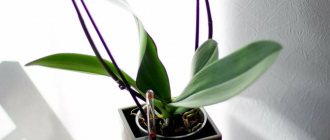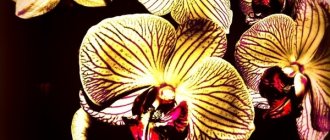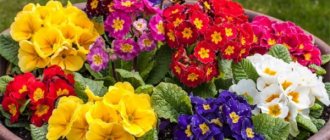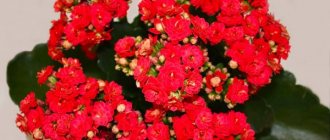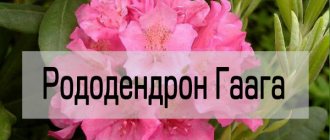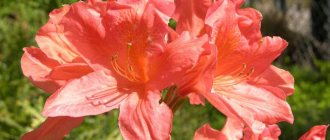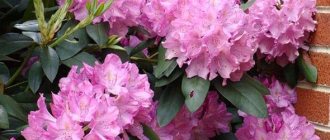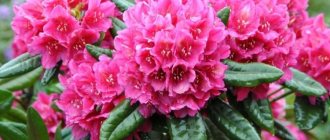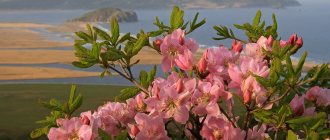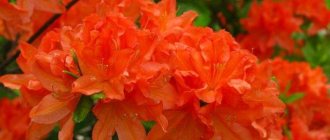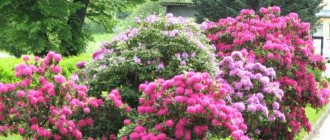When you look at this bush, you immediately associate it with a large pink tree. This is absolutely true, and this is how the word rhododendron is translated from Greek. Basically, the name consists of two separate words - “rhodon”, meaning “rose” and “dendron”, meaning “tree”. Rhododendron is a plant that has confidently won the hearts of both experienced gardeners and beginner amateurs. The luxurious and fairly long-lasting flowering of this gorgeous bush will not leave anyone indifferent.
History of the garden plant rhododendron
One of the most striking representatives of the Heather family, rhododendron (Rhododendron), is represented by shrubby plants and trees. If you read the species definition, there are:
Gorgeous rhododendron bush
- evergreen;
- deciduous;
- semi-deciduous.
Different sources describe different numbers of plants in this genus. On average, it unites from 800 to 1300 plants, including azaleas, which are very popular in indoor floriculture.
For reference: among domestic flower lovers it is the azalea that is usually called “indoor rhododendron.”
Features of growth
Rhododendrons can grow in any area and climate - you just need to choose the right variety. This is not a problem, since there are about 3 thousand species. This is a fairly unpretentious plant that tolerates replanting well, as it has a shallow root system that can be dug out with a shovel.
Selecting a location
If there is any building on the site, then the rhododendron bush must be planted on the north side. The place will be located in the shade, which will suit everyone, since most garden ornamental crops prefer a southern, well-lit bed.
Rhododendrons are not recommended to be planted with those plants whose root system is located at the same level as the bush. In this case, they will compete for nutrients:
- Linden;
- alder;
- chestnut;
- willow;
- poplar.
You can plant it next to a pear and apple tree - these are the shrub's favorite neighbors, as well as oak, pine and larch. This will be mutually beneficial, because rhododendron needs acidic soil, and needles can provide the desired pH level.
If there are still no options, then the rhododendron root is protected by an underground structure - slate or other hard material is dug in so that the plants can be watered and fed separately.
Since the rhododendron bush does not like stagnant moisture in the soil, it is necessary to check at what depth the groundwater lies in the area. If the distance is less than a meter, create an artificially raised bed for rhododendron. Its height must be at least 50 cm.
If the plant does not accept the place to which it was assigned, it is advisable to replant it, otherwise there will be permanent problems with decorativeness.
Temperature in summer and winter
If you choose the right variety for the climatic region, there will be no problems with growing it in summer and winter. It is not advisable to violate the rules for choosing a location, since the bright rays of the sun have a bad effect on flower stalks - they fade faster. This is especially true for late-blooming rhododendrons.
In winter, rhododendron needs a maximum temperature of 5 to 8 degrees, as flower buds grow.
In room conditions, maintaining the temperature regime is much more important. Indoor rhododendron is called Azalea. Many people buy beautiful flowering plants in the store, but after a week they begin to wither.
The thing is that even in summer, azalea should be at a temperature of 10 to 15 degrees, and in winter at 6 to 8. It is almost impossible to achieve such a low temperature in an apartment, so the crop will not last long.
The best option is a winter garden that is not heated, but then it should only contain plants of this type, since low temperatures are contraindicated for others.
Important! Before you buy an expensive plant you like (azaleas and rhododendrons are far from cheap), you need to read about the conditions for their growth in an apartment
At high temperatures, indoor rhododendrons begin to get sick and are affected by pests - primarily spider mites. It is very difficult to cure a plant without changing temperature conditions. The second disadvantage is poor rooting of cuttings for propagation.
Watering
Most rhododendron flower trees like moist soil and do not tolerate drought well. Rhododendron is watered frequently, as its superficial root system is not able to reach water deeper than 1 m, so it quickly dries out. With each watering, there should be enough liquid to moisten the soil layer to a depth of 35 cm.
The water must be soft, as the plant does not tolerate lime salts. To do this, it is advisable to keep a barrel of rainwater in the yard. Mulching with pine needles will help preserve moisture, as they decompose and maintain an acidic environment.
During the hot season, it is useful to sprinkle, but this should be done in the evening so that the leaves also have time to become saturated with moisture overnight. The plant needs the most water during the flowering period so that the inflorescences do not fall off prematurely. When the rhododendron blooms, you can put a hose under the bush and turn on a little pressure. To prevent water from spreading, build an earthen rampart around the bush.
Young bushes require more frequent watering - 4 - 5 times a week in the summer. Adult plants - three times a week. To maintain the desired acidity level, add citric acid to the liquid - 4 g per bucket of water. Sorrel, wine, and vinegar are also suitable.
After watering, the soil must be loosened, but do this carefully so as not to damage the roots.
Soil and acidity requirements
The soil for rhododendrons is prepared at the planting stage. To do this, mix acidic high-moor peat with sand and garden soil. You can add sawdust from coniferous trees - they have high acidity, so they are not used on other plants.
The roots must receive enough air so that they do not rot in an acidic environment. If the site consists of loam or even heavier clay, the soil for rhododendron is made up of several components, most of which will be loose. Take in equal parts:
- humus;
- high peat;
- sand.
A high humus content is another condition for growth and flowering. Humic acids have a positive effect on the immunity of all ornamental crops. They contain vitamins and chemical compounds that are responsible for metabolism. Humus is added to the soil to attract soil microorganisms and earthworms to process it into humus.
Before planting rhododendron, it is recommended to test the soil for acidity. You can use a pH meter that is pre-calibrated in distilled water. There are also traditional methods. One of them is based on the use of black currant or cherry leaves.
How to check:
- Pour boiling water over a handful of leaves and wait for them to brew.
- Take soil from the garden bed where you plan to plant rhododendron.
- Throw it into a glass with tea leaves.
If the liquid has changed color and turned green, then the soil on the site is neutral - you need to add acidic components. Red color indicates a normal acid level - in this case, nothing needs to be done. The blue color of the tea leaves indicates that the soil is slightly acidic; you need to add a little sawdust or pine needles. The overall pH level should be between 4.5 and 5.5 units.
Typically, experienced gardeners recommend preparing a bed for rhododendrons in the fall by digging up the soil with pine sawdust or needles. Over the winter they will have time to rot and create suitable conditions for planting rhododendrons. The layer height should be about 35 cm.
Feeding
It is possible to “feed” such large inflorescences only by regularly adding nutrients to the plant. Caring for rhododendron during and after flowering includes the use of organic and mineral fertilizers. You can find special complex mixtures of acidic substances on sale so that you don’t have to make them yourself.
Recommended acidic fertilizers:
- Potassium sulfate is added to stimulate and maintain flowering.
- Superphosphate.
- Ammonium sulfate, magnesium.
The secret why rhododendron blooms so luxuriantly lies in the peculiarities of its metabolism. Flowering requires a lot of phosphorus and potassium, but potassium is absorbed to the extent that phosphates are processed. To dissolve phosphorus in the soil, an acidic environment is needed - in the case of rhododendron and its large inflorescences, which consume a lot of nutrients - very acidic.
Plants need to be fertilized in early May (no later than mid-May). If there are not enough iron ions in the soil, the leaves will begin to turn yellow. The same applies if the soil has lost acidity. Beginners sometimes spoil the bush themselves by adding wood ash as an organic fertilizer. The fact is that it contains a large amount of carbonates, which alkalize the soil, which is fatal for rhododendron.
If the conditions for acid fertilizing and watering are not met, the plant begins to suffer from chlorosis and produces few flowers, as it saves energy. Weakened bushes are prone to pest infestation and cancerous tissue damage.
Where is rhododendron common?
When does hydrangea bloom - flowering period, how long does it bloom
In nature, it grows mainly in the Northern Hemisphere - the territories of Southern China, the Himalayas, Southeast Asia, North America and Japan. Some representatives are found in the Far East and the Caucasus; they also grow in the climatic conditions of Ukraine. They can be located singly, or in whole groups.
Most often they prefer the northern slopes of the mountains, along which they can climb to the alpine zones. The plant needs high air humidity and a little shade from other shrubs or trees.
It is interesting that in modern botany two genera of plants have been combined - wild rosemaries and rhododendrons. As a result, the plant, which was called “swamp wild rosemary,” was renamed “rhododendron.” So, the Ural wild flowering rhododendron is now national pride and a symbol of the inhabitants of central Russia.
In central Russia, semi-evergreen and deciduous plant species take root best. When grown in the garden, they almost never exceed 1.5–2 m in height, although rhododendrons in nature can be much taller. Crown can be:
- ellipsoid;
- spherical;
- branched.
Marsh wild rosemary
Description and features of rhododendron
The genus rhododendron contains both shrubs and trees.
Plants of this type are:
- Evergreen. This variety includes shrubs that do not shed leaves. For their normal growth, soil with peat and diffused light are required. The buds of such rhododendrons are large. The color of the petals ranges from white to purple.
- Semi-deciduous. These are shrubs and small trees. They are compact in size. They tolerate winter well and are frost-resistant. A large mass of leaves falls off with the onset of cold weather, but several leaves remain at the tips of the branches. The latter give rise to new foliage with the arrival of spring.
- Deciduous. Small shrubs that bloom profusely in autumn and spring. Not demanding in care. They tolerate frost well.
In total, the genus includes more than 3 thousand species. This also includes azalea (house rhododendron).
What is rhododendron? In translation, the name sounds like a tree, a rose. Therefore, the plant is called, for example, an alpine rose.
They prefer rhododendrons on the coast and mountain slopes. The homeland of the plants is the southern part of China, Asia, America, and the islands of Japan. Some varieties of shrubs grow about 3 m, while others spread along the ground. Plant buds differ in shape and color of petals. The largest flower is 20 cm in diameter.
Alpine rose flowers are round, conical, tubular, or bell-shaped.
The buds are collected in inflorescences shaped like brushes or scutes. The leaves are hard, alternately located on the branches. After flowering, boxes filled with seeds form on the branches. The seeds are large, but not more than 2 mm.
Rhododendrons have a fibrous root system. The roots are located near the surface of the earth.
The rhododendron tree easily adapts to new conditions after transplantation.
You can read everything about peony roses here.
Properties of rhododendron
The rhododendron flower is valued for its lush blooms and variety of colors. Used in landscape design.
Rhododendron flowers are used to create fragrances. Perfume is made from extracts. The plant is used in the treatment of certain diseases. The above-ground part of the alpine rose contains essential oils, ascorbic acid, tannins, tannins, arbutin, phytoncides, etc.
Products based on Alpine rose have a diaphoretic, antipyretic, soothing, analgesic and bactericidal effect, and cope with staphylococcal infections, pathogenic microorganisms, and streptococci.
Rhododendron contains toxic substances, so it should not be used by nursing women, pregnant women or those suffering from kidney failure.
When does rhododendron bloom and how long?
Rhododendron flowering begins in mid-spring and lasts until mid-summer. The ripening of buds depends on the plant variety.
Evergreen rhododendrons bloom in late spring, deciduous ones in early summer.
On average, the duration of flowering is 16-20 days, with a maximum of 45 days.
The size and type of buds are affected by the amount of nutrients in the soil, temperature and daylight hours. Some varieties bloom again closer to autumn. The flowering period lasts from August to October.
When planting a plant from seeds, flowering should be expected after 6-7 years. The young plant produces buds already 4 years after planting.
Popular varieties and varieties
It is recognized that approximately 40 species of this shrub can grow in central Russia.
Why rhododendron does not bloom in open ground in the garden: what to do
The lush inflorescences of the bushes consist of 20-30 flowers, shaped like bells. The inflorescences are located at the ends of the branches. Surrounded by dark green glossy leaves, the inflorescences resemble huge bouquets. In the middle zone they are considered one of the first shrubs to bloom in spring. The types of this popular shrub should be considered based on their foliage.
Evergreens are distinguished by the fact that in winter, such rhododendron does not shed its leaves, but simply rolls them into a tube, unfolding them when a comfortable temperature is established outside.
The most popular evergreen shrubs include the following species:
- Katevbinsky;
- grandiflorum;
- Pontic;
- roseum elegans;
- Alfred.
Semi-evergreen species include:
- Sikhote-Alinsky;
- ledebura.
The most popular deciduous varieties are rightfully considered:
- Daurian;
- yellow;
- Japanese;
- Canadian;
- Kamchatka;
- dense.
All varietal species differ from each other in the splendor of flowering, variety of colors and shapes.
This is interesting: in some places there are even rhododendrons in the form of fairly large trees, comparable in size to an apple tree.
Plant care
The transplanted plant requires attention and careful care. In addition to regular, abundant watering, rhododendron requires foliar spraying, especially when planting in late spring. The soil needs to be mulched to retain sufficient moisture. When mulching, you should choose options that increase the acidity of the soil.
The plant requires regular watering
The root system of rhododendrons consists of delicate, thin hairs, similar to matted hair, so loosening the soil, especially deep, should be excluded from flower care measures. Weeds that grow near the plant must be removed periodically.
The appearance of the plant will immediately indicate a lack or excess of water - the leaves of the rhododendron will begin to turn yellow and fall off. Watering must be carried out in sufficient quantities, but without overflowing; this is one of the main rules for caring for crops.
To ensure proper care of rhododendron, it is important to carry out timely pruning of overgrown bushes. To prevent infection of the plant, the cut areas are covered with paint or garden varnish.
Bushes need to be trimmed periodically
Compliance with simple plant care requirements will allow you to grow a wonderful flowering bush.
Preparing for winter
Like any cultivated plant, Bloombux rhododendron requires some activities in the fall. If there has been no rain for a long time and no precipitation is expected, then you will have to water the bushes well. After abundant irrigation, mulch the tree trunk circle. Mulch will not only retain moisture in the soil, but also protect the root system from frost. The layer should be at least 15-20 cm.
In areas with a sharply continental climate, where in winter the thermometer drops below 27 degrees, the bushes are tied with twine and then covered with spruce branches.
In the south such shelter is not required.
Winter hardiness of rhododendron Bloombooks
Almost all rhododendrons, including Bloombux, are frost-resistant plants. If you mulch the tree trunk well to cover the roots, the hybrid can withstand temperatures down to -25 degrees. At lower temperatures, without shelter, the buds may freeze.
Trimming
Thanks to pruning, Rhododendron Bloombooks can be given any shape, which is why the plant is widely used by landscape designers to decorate the site. The fact is that the plant responds well to pruning: the greenery is preserved, the bushes do not get sick. During pruning, you need to remove the growth growing from the roots, otherwise it will choke the bush and flowering will be insignificant.
Rhododendron should be pruned after flowering to avoid damaging the flower buds. But you can replant the bushes only 2-3 weeks after flowering or early in the spring, until the buds swell.
Caring for rhododendron after flowering
Immediately after flowering, the inflorescence is cut off or carefully torn off by hand, trying not to touch the young shoots. If everything is done correctly, then two or three new young shoots will appear in place of the previous inflorescence.
Two weeks after the last feeding, rhododendrons are pruned for rejuvenating or sanitary purposes, leaving the desired height of the plant. The same rejuvenating pruning is carried out in the spring, removing part of the branches above the dormant buds - small thickenings of a pinkish tint on the shoots.
If the rhododendron was grown from seeds, then formative pruning cannot be carried out before the first flowering - otherwise the buds will appear no earlier than after 2-3 years.
In the fall, rhododendron is not fed, but in order to help the roots survive the winter, even before the onset of frost, the soil is mulched with a 5-centimeter layer of rotted manure.
How long does rhododendron bloom?
Gardeners are often interested in the question of how long rhododendron blooms. The timing of flowering of a shrub is influenced primarily by climatic conditions, region of growth, plant variety and its condition. In most cases, the flowering period begins in April and ends in June.
Caucasian rhododendron in the mountains: when to bloom
Early flowering shrubs open the flowering period (April, May), then evergreen species pick up the baton and the flowering season ends with deciduous species.
How long rhododendron blooms also directly depends on a particular variety. In general, flowering lasts 15-20 days, but some shrubs can delight with gorgeous inflorescences from 30 to 45 days. In addition to the variety, the following factors also influence the flowering time:
- brightness and amount of light;
- air temperature;
- soil saturation with nutrients.
Important! Rhododendron is one of the obstinate plants. Therefore, in order not to experience bitter disappointment and not to destroy the plant in your garden, you need to familiarize yourself with all the intricacies of caring for it.
Planting a plant in open ground and preparing the site
What does rhododendron need for normal growth and development:
- Intense but diffused light. From direct sunlight, rhododendron (especially evergreen) will quickly burn the leaves. It can be planted, for example, in the shade of taller trees with a root system deep into the soil (pear, oak, pine, apple tree). Unsuitable “companions” are willow, linden, chestnut, birch.
The “openwork” crown of many trees provides just the kind of light partial shade that rhododendrons need
- Protection from drafts. Rhododendrons tolerate winter frosts calmly, which cannot be said about gusts of cold wind. Plant them at a distance of 2–4 m from the fence, wall on the west or east side.
- Loose acidic (pH 4.5–5.5) substrate. In nature, the roots are found in a kind of “litter” of podzolic soil and fallen leaves (rotten and fresh). It is no different in terms of nutrition. Rhododendrons, like all Heathers, do not have hairs on their roots, therefore they exist in a stable symbiosis with mycorrhiza - the simplest fungi that settle directly in their tissues. This mycelium requires a constant flow of air, otherwise it dies.
- Lack of close (up to a meter) groundwater approaching the soil surface. Rhododendron suffers from both deficiency and excess moisture, but the latter is more dangerous, as it provokes the development of rot. If there is no other place, you will have to build a raised bed.
The method of planting rhododendron depends on the quality of the substrate and how close to the surface the groundwater comes
When choosing a seedling, give preference to 3-4 year old specimens. They take root faster and better. Rhododendrons can be planted in both spring (April) and autumn (September). The first option is practiced in regions with a temperate climate, the second - in southern regions. The distance between several rhododendrons is determined by their dimensions (from half to 2/3 of the crown diameter), but in any case it is at least a meter.
The distance between two rhododendrons when planting several specimens at once is determined by the dimensions of the adult plants
Rhododendron requires a specific substrate. In any other soil, the plant does not bloom, grows very slowly, gets sick more often, and develops chlorosis. The easiest way is to fill the planting hole with purchased soil for Heathers, but you can prepare the mixture yourself, mixing approximately equally:
- high red peat;
- forest coniferous “litter” (a mixture of humus with half-decomposed cones, pine needles, small twigs, and other plant debris);
- coarse river sand or sandy soil;
- rotted sawdust of any coniferous tree.
Suitable soil for rhododendron can be purchased in stores.
The dimensions of the planting pit are about 0.5 m deep and 0.6–0.7 m in diameter. Place 5–7 cm of drainage at the bottom, then fill it halfway with the substrate, moisten it by pouring 3–5 liters of water. Rhododendron seedlings are usually sold with a closed root system, in containers. To make it easier to remove them from the container, the plants are also watered a couple of hours before planting. A depression is made in the soil corresponding to the size of the earthen ball, and soil is added. The root collar should be left at the same level as before. The planted rhododendron is watered again (about 10 l) and the trunk circle with a diameter of 0.5 m is mulched with pine needles, rotten sawdust, and fallen leaves (layer 5–7 cm).
During the process of planting rhododendron, control the position of the root collar - it must not be buried in the soil.
Video: how to plant rhododendron correctly
Rhododendron tolerates transplantation easily. Its possibility is limited only by the size of the plant - adult specimens cannot be removed from the soil purely physically. Any time is suitable for this, except frost, even the flowering period. But it is best to do this in early spring or mid-autumn, and not during the active growing season.
The bush is dug around the perimeter to a depth of 30–40 cm, removed from the soil along with a lump of earth and transferred to another place on a piece of dense polyethylene, fabric, or a sheet of plywood. When transplanting, the root collar should be 2–3 cm higher than before.
What colors are rhododendrons?
Rhododendron is the largest shrub in terms of diversity of species. Therefore, you can easily choose a bush that matches the color of your landscape design. For example, if you need a blue, lilac or purple bush, inflorescences of these shades are:
- attractive;
- Katevbinsky;
- dense;
- merrin;
- Canadian;
- Pontic.
If you prefer red flowers, you should pay attention to the inflorescences:
- Kamchatka;
- blood red;
- Albrecht;
- rusty.
Pink inflorescences in:
- Canadian;
- Daurian;
- the largest.
The Japanese variety will delight you with salmon and orange flowers.
And here are the yellow flowers:
- nail-shaped;
- yellow;
- golden.
The following inflorescences will delight you with white and cream flowers in the garden:
- short-fruited;
- Atlantic;
- sticky;
- Adams;
- tree-like;
- Caucasian.
You can always choose a variety that will optimally fit into the overall landscape design of any site.
Care by region
It is not enough to choose a frost-resistant or heat-loving variety; you need to be able to care for it in the open ground, since the weather is constantly changing - today it rained, which means watering can be canceled, or vice versa - the weather is dry, so the bush needs water every day.
Moscow region
In the Moscow region, temperatures in summer rise to 28 - 30 degrees, in winter frosts down to minus 20 . To better understand the needs of rhododendron, you need to find out about the characteristics of the variety in the nursery.
What to ask:
- Is it necessary to cover the bush completely or is mulching sufficient?
- At what age can a plant overwinter without shelter?
In the climate near Moscow, all types of rhododendron are successfully grown; the specifics of care depend on whether the deciduous, evergreen or semi-deciduous variety appears on the site.
The varieties of American selection are particularly winter hardy - Golden Lights, Rhodium Lights, Mandarin Lights, Lemon Lights. They all withstand frosts down to minus 36 degrees, which is quite enough for the Moscow region.
Of the evergreen species, the already famous Helsinki, grandiflorum and The Hague are suitable. Japanese species are less resistant to frost - they can only withstand minus 25. They are covered for the winter and mulched, and in the spring they make sure that the plant does not become trapped inside the agrofibre.
Another plus for shelter is winter sun. Even morning rays can damage nascent buds, so it is better to cover the bush. Drying of the buds can occur even with evergreen frost-resistant species - they are covered with one layer of agrofibre.
Important! If the buds are brown, then the sun has already damaged them and there will be no flowering. Next year you need to protect the plants in time
Siberia, Ural
In the cold northern climate, rhododendrons are almost the only plants you can admire. But those plants whose frost resistance is above 36 degrees are suitable for planting. In the Siberian climate, even they will have to be wrapped in a triple layer of lutrasil and mulched with spruce branches. Some local gardeners use old coats and padded jackets, as well as pieces of felt for the roots.
In Siberia and the Urals, plants more often suffer from strong piercing winds, so they are planted under the protection of other trees or buildings.
Southern regions
In southern climates or in the European part, rhododendrons suffer more in summer than in winter. The absence of severe frosts and winds create favorable conditions, but in summer the plants need to be watered and sprayed frequently to enhance gas exchange in the tissues.
It is advisable to plant bushes so that the sun shines on them only in the morning or only in the evening. Large spreading trees, such as oaks or thujas, can serve as protection.
Chemical composition
It is important to know about rhododendron that it is a poisonous plant. The dangerous properties are associated with a substance contained in the composition called andromedotoxin (also called rhodotoxin, acetylandromedol).
Varietal rhododendron at home
This cyclic diterpene is classified as polyhydroxylated. According to the mechanism of action, it is comparable to neurotoxins and is characteristic of almost all Heathers.
The action of this toxic substance is based on the ability to disrupt the functioning of cellular receptors. Initially, the central nervous system is excited, and then comes into a state of depression. This mechanism of action is quite capable of leading to death. This information is not known to everyone, but it eliminates all doubts about whether the rhododendron bush is poisonous or not.
Decorative use
Not a single gardener, having once seen this flowering shrub, will deny himself the pleasure of planting it on his site. Many believe that it is incomparable to any other decorative flowering plant. And if many call the rose the queen of the garden, then the rhododendron is deservedly called its king.
The year a young rhododendron blooms after planting is influenced by many circumstances - applied fertilizers, weather conditions, care. A high decorative effect can be achieved already from the first year of planting seedlings by purchasing large-sized plants aged 5-8 years with a formed crown and flower buds ready to bloom.
Also, the effect in decorative use largely depends on exactly how the plant is located on the site.
Important! Since rhododendron grows for a long time, you need to buy either mature bushes, or immediately expect that it will show itself in all its glory decades later.
How to cover a rhododendron for the winter
It is important to cover the plant correctly and on time - it forms flower buds at the ends of the shoots in the previous season. The shrub can withstand low temperatures well, but is afraid of the cold winter wind and the bright sun reflected from the snow.
The greatest danger to a plant when caring in open ground is loss of moisture during the dormant period. It is equally contraindicated for deciduous and evergreen species - if they dry out, flower buds will form next time in the new season, and will bloom in a year. And this is the best option.
Not only the ends of shoots, but also entire branches or the entire plant can die from moisture deficiency.
The next problem is that under the bright sun, not only transpiration is activated. The crown heats up, the buds receive a signal to awaken (in rhododendron, growth processes resume early), and the root is in frozen soil and cannot provide the plant with moisture or nutrition.
So not only in cold regions, but also where there is usually snow in winter, all plants need to be covered. Even when growing rhododendrons in places protected from the wind. If the shrub is planted in partial shade, this will not completely protect it from the drying sun.
Hilling
The agrotechnical technique hilling is the rolling down of the projection area of the plant crown with soil, carried out during loosening. But the root system of rhododendron is superficial; its trunk circle needs to be mulched and not hilled, so as not to damage the underground part.
It is recommended to use litter from healthy coniferous trees - usually pine is used; covering material cannot be taken from under fir trees.
The bark is suitable - it is sold in garden centers already treated for diseases and pests by the manufacturer. Not the worst option is high-moor peat.
To preserve the root system of plants, you need a layer of mulch covering the entire crown projection area:
- for low-growing shrubs up to 50 cm – 5 cm;
- large rhododendrons – 20 cm.
Covering plants with non-woven material or spruce branches does not replace mulching of the root zone. These agricultural techniques complement each other.
Protection with agrotextiles
You only need to rush to cover the plants planted this season. Well-rooted shrubs can easily withstand frost of -10° C. If you build protection earlier, they will freeze, which is even more dangerous than frostbite and is almost guaranteed to lead to the death of the plant.
Hardening the rhododendron by letting the temperature drop several times to -2-3° C is even useful if the moisture charging is carried out correctly. There is no need to be afraid that the leaves of evergreen species will become soft, curl, droop, or press against the branches. When the weather warms up, the turgor will return and they will gradually straighten out.
To cover plants, use white or beige spunbond or lutrasteel. As an auxiliary material for additional insulation in cold regions - jute or burlap.
What needs to be done in advance is to install the frame over the rhododendron - sticking the ends into the frozen ground is difficult. It should be made of durable steel, preferably in the form of a cone (so that snow rolls off). But for tall plants this is problematic; owners often stick a pole close to the root collar, around which they build a pyramid.
As soon as the temperature drops below minus 10° C, a cap made of non-woven material is pulled over the frame. The ends are secured with staples or pressed down with stones.
In spring, there is no need to rush to remove the cover from the plant. They do this only after the snow has melted and immediately begin to water and spray the bush. If the evergreen rhododendron has lost its plates, and the deciduous one has clearly shrunk, daily dosed irrigation of the crown and root zone can revive the shrub. It will not bloom for several seasons, but it will survive.
Covering with branches
The rhododendron is covered with spruce branches and tied with twine. The method is good for small shrubs. For large plants, if possible, you can bend the branches and pin them to the ground, but so that the wood does not crack.
Creeping types of rhododendron, low-growing or young plants are sometimes completely covered with leaves, preferably oak leaves. And they are covered with agrofibre so that they do not fly apart. Cellophane cannot be used - it does not allow air to pass through.
But it is recommended to do this if the owners are sure that a snowy winter will not give way to thaws. Wet leaves are not the best shelter for rhododendron, although it suffers precisely from loss of moisture.
Rhododendron in the landscape
It is considered a universal ornamental plant. This is especially true for the period when rhododendron is in bloom and bright inflorescences cover the bush from top to bottom.
The plant looks great both in group plantings and as a tapeworm against a background of emerald green grass. It goes well with many types of decorative flowering and decorative foliage plants.
In landscape design it is used to create a hedge. Universal in uniform plantings. Often used for planting near artificial ponds or streams.
What diseases does rhododendron treat?
In medicine, a description of the phytoncidal, bacterial, and insecticidal properties of this plant has long been compiled. Tannins and ascorbic acid were identified in it. It is obvious that the plant has medicinal properties. Products containing it are used as:
Rhododendron flowers for making medicines
- antipyretic;
- diaphoretic;
- painkiller.
Shows good results in the treatment of diseases of the cardiovascular system. It is rich in substances that increase the power of heart contractions and, accordingly, increase blood flow.
With the help of this plant, problems with:
- rheumatism;
- chronic colitis;
- vegetative neuroses;
- epilepsy;
- uterine erosion;
- a cold.
In folk medicine, infused leaves of the plant are mainly used.
Important! Considering the completely harmless substances contained in the leaves, the plant should be used at home with extreme caution. It is important to ensure that the child does not drink the infusion.
Pests and diseases
The main diseases of rhododendron are fungal. These include canker and chlorosis, as well as rust or leaf spot. As a rule, such diseases are caused by poor aeration of the plant roots. If the leaves show signs of spotting or rust, they can be dealt with by treating the bush with products containing copper. Among them is Bordeaux mixture. If the plant's foliage has turned yellow, chlorosis is the likely cause. It is combated with the help of iron chelate, which is diluted in water when watering. Cancerous lesions need to be cut back to healthy areas. In advanced cases, the branches are completely removed. To prevent the development of such diseases, in early spring and late autumn, plantings are treated with Bordeaux mixture, spraying the foliage with it.
Rhododendron can be a target for a variety of garden pests. Manual collection of them will help to cope with the invasion of snails or slugs, and treatment with a fungicide solution (Tirama or TMTD, 8%) can prevent their appearance. If bedbugs or spider mites are noticed on the bush, it is treated with Diazinon. If weevils have settled on a plant, they will have to treat not only the bush itself, but also the soil surface adjacent to it. Karbofos is used to combat all other insects (scale insects, mealybugs, etc.). It is used strictly according to the instructions.
How to grow rhododendron from seeds at home
Propagation by seeds is the main thing for this shrub. Plant cuttings have a weaker root system, and the bush does not become bulbous at all. Sowing is done in January. Rhododendron seeds are small; they are sown on the surface of previously prepared soil. In order for them to germinate, the following rules must be followed:
- temperature regime − +25 °С;
- mandatory lighting;
- spraying with a spray bottle - daily;
- ventilation.
Important! When the first shoots appear, you need to start fertilizing with weak solutions of fertilizers specifically designed for this type of shrub.
Strong seedlings of rhododendron bushes are planted either in a greenhouse or in open ground, depending on weather conditions. The theory of how to grow rhododendron from the smallest seeds is not complicated, the main thing is to strictly follow all the recommendations.
Reproduction methods
Rhododendrons bred by breeders reproduce exclusively vegetatively:
- By cuttings. Cuttings about 15 cm long are cut in June, after flowering. Leaves, except the top two or three, are removed. The lower oblique cut is dipped into a container with a biostimulator solution for a day. The cuttings are rooted in a mixture of peat, sand and soil from under coniferous trees (1:1:1), creating a “greenhouse effect”. Plant in a permanent place next spring.
Rhododendron cuttings produce roots in 4–6 weeks
- By layering. In mid-spring, they dig a groove about 10 cm deep, bend the young flexible shoot to the ground, cut the bark from below, and fix it in this position. A mound of humus is poured on top and watered well during the season. By autumn, shoots should appear. The seedling is separated from the mother plant in the spring.
Reproduction of rhododendron by layering will not take much time and effort from the gardener
Juice from petals of rhododendron dahurian
Scientists have discovered the following beneficial substances in the petals of the plant:
Daurian rhododendron
- fructose;
- phytoncides;
- resins;
- essential oils;
- vitamins A, C, E.
It is not surprising that the juice from this amazing plant, which is also called rosemary, is used in medicine. In combination with fresh cream, juice obtained from the petals treats:
- stomach and duodenal ulcers;
- thrombophlebitis;
- wound surfaces.
Having learned what rhododendron is and having become familiar with all the growing and care conditions necessary for the plant, you can decide whether it is worth planting it on your site.
